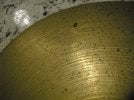- Joined
- Dec 29, 2020
- Messages
- 214
- Reaction score
- 189
Hi all.
Here is yet another request to identify a Zildjian stamp. I did my own checking and think this may be a late 50's small stamp SSB.
It is a 20" and the pictures are all I have. Going to check it out tomorrow but trying to do my due diligence.
Am I correct or way off? Trying to learn as I go so any confirmation or correction is appreciated. Thank you!


Here is yet another request to identify a Zildjian stamp. I did my own checking and think this may be a late 50's small stamp SSB.
It is a 20" and the pictures are all I have. Going to check it out tomorrow but trying to do my due diligence.
Am I correct or way off? Trying to learn as I go so any confirmation or correction is appreciated. Thank you!
![[DFO] Drum Forum](https://www.drumforum.org/styles/drumforum/xenforo/logo.png)



